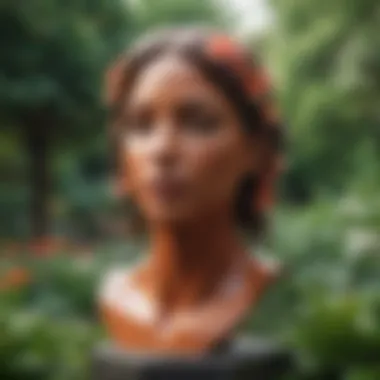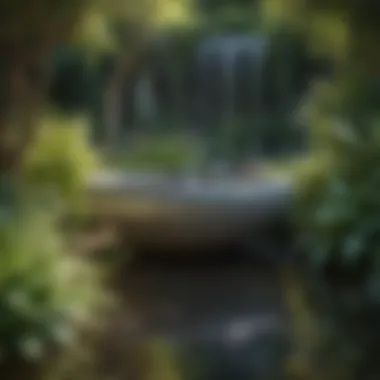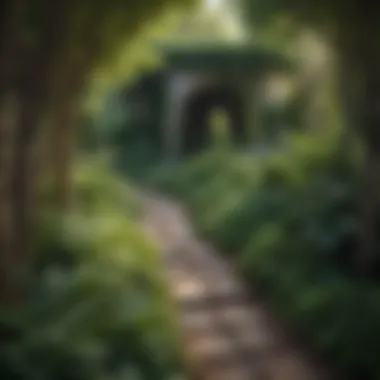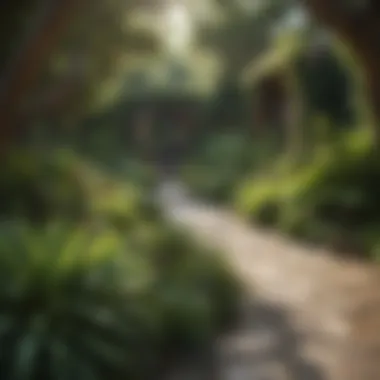Outdoor Garden Artwork: Design and Aesthetic Impact


Intro
Outdoor gardens serve as a canvas for creativity, and integrating artwork can transform these spaces into reflective and vibrant sanctuaries. This article explores how outdoor garden artwork interacts with design to enhance the visual and emotional impact of gardens. Whether through sculptures, pottery, or murals, each form of art adds a unique layer to the overall aesthetic. The discussion will extend beyond mere decoration; it will showcase how these artistic expressions contribute to a deeper understanding of space and environment.
The significance of art in gardens is multifaceted. Art provides a focal point, encouraging engagement and contemplation. It can also reflect personal tastes, values, and cultural backgrounds, making gardens personal extensions of their owners. As we investigate the connection between outdoor art and design, practical tips for integrating various forms of artwork with landscape architecture will be highlighted. How does one choose the right piece? Where should it be placed? What maintenance is required? These considerations will guide homeowners and gardening enthusiasts alike to curate a sanctum that resonates with their vision and lifestyle.
Design Inspirations
Incorporating artwork into a garden requires careful thought about design inspirations. The fusion of art and design can make outdoor spaces strikingly beautiful. Effective integration considers trending styles and color palettes.
Trending Styles
The gardening world has seen an evolution of styles, from minimalist to bohemian chic. Many homeowners are opting for contemporary pieces that introduce clean lines and modern aesthetics. Others incorporate rustic or vintage art that evokes nostalgia and warmth. Popular styles include:
- Sculptural Elements: Abstract sculptures or kinetic pieces that engage the viewer.
- Functional Art: Items such as benches or planters that serve a purpose while enhancing beauty.
- Nature-Inspired: Art that reflects natural forms, materials, and themes that harmonize with the environment.
Color Palettes
Choosing the right color palette is essential in outdoor spaces. Consideration should be given to how colors interact with one another and with plants. Here are some tips for selecting effective color schemes:
- Neutral Tones: Whites and greys create a backdrop that highlights bright-colored artwork.
- Earthy Colors: Greens, browns, and terracottas align harmoniously with most garden settings.
- Accent Colors: Use vibrant shades like reds or yellows sparingly to draw attention to key art pieces.
However, each choice must be informed by the overall design philosophy of the garden.
The alignment of art with the natural environment can create a cohesive and welcoming outdoor space.
Maintenance and Upkeep
The incorporation of artwork into gardens also comes with responsibilities. Understanding maintenance strategies is crucial for ensuring the longevity and beauty of these pieces.
Seasonal Maintenance Checklist
Different seasons bring different challenges. Here is a seasonal checklist to keep in mind:
- Spring: Inspect for weather damage and clean mildew or dirt.
- Summer: Check for fading from sun exposure and touch up paint if necessary.
- Fall: Prepare artwork for winter by ensuring it is secured against high winds.
- Winter: Store sensitive pieces indoors if possible, or protect them with covers.
Cleaning and Organization Tips
Keeping outdoor artwork clean enhances its appeal. Regular maintenance should include:
- Dusting: Use a soft cloth to remove dust and debris.
- Pressure Washing: For sturdier pieces, this method can effectively remove grime.
- Labeled Storage: Organize seasonal decorations and tools for easy access and minimize clutter.
By approaching the topic of outdoor garden artwork and design with a thoughtful mindset, homeowners can create distinctive and meaningful spaces that elevate their outdoor experience. Engaging with art not only beautifies a garden but also invites the potential for personal reflection and enjoyment.
Understanding Outdoor Garden Artwork
Outdoor garden artwork occupies a unique place in the intersection of creativity and design. This art form enhances outdoor spaces, elevating them from mere patches of land to engaging environments that invite exploration and relaxation. Understanding outdoor garden artwork is essential for homeowners and gardening aficionados as it reveals how art interacts with nature, transforming gardens into personal oases.
The benefits of recognizing the importance of garden artwork include increased aesthetic appeal, improved mood, and a more defined outdoor space. Specifically, selecting and integrating the right pieces can create a harmonious relationship between the garden and the surrounding environment. It encourages mindfulness, as the interplay of art and nature presents opportunities for introspection and enjoyment.
In this section, we delve into the foundational elements that define outdoor garden artwork, its rich historical context, and its diverse cultural expressions. These aspects form a comprehensive understanding of how art can redefine outdoor areas.
Defining Outdoor Garden Artwork
Outdoor garden artwork encompasses a variety of creative expressions placed in gardens or other external spaces. It includes sculptures, fountains, murals, and any artistic installation meant to beautify or enhance a landscape. One crucial aspect to consider is that this artwork must withstand outdoor conditions, including changing weather and exposure to natural elements.
This definition, however, extends beyond physical artworks. It also includes functional pieces that serve a purpose while providing aesthetic value, such as decorative benches or tables. The seamless blending of utility and visual appeal represents a core principle in outdoor garden artwork.


Historical Context of Garden Art
The concept of integrating art into gardens is not new. Historical records show that gardens have been canvases for artistic expression for centuries. For instance, during the Renaissance, elaborate gardens adorned with sculptures and ornate fountains symbolized wealth and status. In Japan, Zen gardens with carefully arranged stones and raked gravel have historically served as spaces for meditation and reflection.
In contemporary times, the focus has shifted toward personal expression and ecological considerations, but the historical roots underline how garden art provides more than mere decoration. It reflects cultural values, ideals, and the human relationship with nature over time.
Cultural Variations in Garden Artwork
Cultural expressions in garden artwork vary widely around the globe. In Western societies, gardens often boast ornamental features such as intricate water fountains and classical sculptures, whereas in Eastern traditions, nature is embraced through minimalism and intentional simplicity.
- In Mediterranean cultures, vibrant colors in ceramic tiles often blend with lush greenery, enhancing both aesthetic and sensory experiences.
- African gardens frequently showcase tribal motifs and carvings, celebrating heritage and storytelling through natural materials.
- Latin American garden art can be characterized by bold murals and the use of whimsical elements, reflecting the region's dynamic culture and vibrant spirit.
These cultural variations underscore the diversity of artistic interpretations when it comes to outdoor spaces. Understanding such differences not only enriches one’s appreciation for outdoor garden artwork but also aids homeowners in selecting pieces that complement their own cultural and personal values.
Types of Outdoor Garden Artwork
Outdoor garden artwork plays a vital role in enhancing the visual appeal and character of outdoor spaces. It serves not only as decoration but also creates an emotional connection between the viewer and the environment. Understanding the various forms of outdoor artwork helps in making informed decisions about what to incorporate into a garden. The right pieces can transform a simple landscape into a rich, meaningful experience.
Sculptures and Statues
Sculptures and statues come in various sizes, styles, and materials, offering endless options for customization. They can serve as the statement pieces, drawing immediate attention. Often crafted from metal, stone, or wood, these artworks add depth and dimension to a garden.
The presence of large sculptures may create a dramatic focal point, while smaller pieces can be strategically placed to surprise and delight viewers. When integrating sculptures into a design, consider their relationship with surrounding plants and structures. A well-placed statue can guide the eye and encourage exploration through the garden.
Wall Art for the Outdoors
Wall art extends beyond the confines of homes and can find its place in the open air. Outdoor wall art, whether made from metal, wood, or weatherproof canvas, adds a personal touch to garden walls, fences, and sheds. Such pieces can reflect the owner's personality or story, making the outdoor space feel more inviting.
This form of art invites creativity. Unconventional materials can be used to create an engaging sensory experience. Choose colors and themes that resonate with the overall garden design to maintain a cohesive look.
Fountains and Water Features
Water features, particularly fountains, provide tranquility and beauty. The sound of flowing water can enhance relaxation, making gardens feel like retreats. Fountains can vary in complexity from simple wall-mounted designs to elaborate freestanding structures.
These installations not only incentivize relaxation but also attract wildlife, such as birds and butterflies. When selecting a fountain, consider the overall layout of the garden. The scale and style should correspond to the surrounding elements to avoid visual imbalance.
Functional Art: Benches and Tables
Functional art pieces serve a dual purpose, combining practicality with aesthetics. Items such as benches and tables can be crafted with unique designs to enhance the outdoor experience. A bench can provide a place to sit and reflect on the beauty surrounding you.
When choosing functional artwork, consider the materials used. Options range from rustic wood to sleek metal, allowing for diverse pairing with other garden elements. It’s also important to ensure comfort while selecting designs that complement the garden's theme.
Plant Art and Vertical Gardens
Plant art creates a living piece of decoration through the strategic placement of plants. Vertical gardens or living walls combine different plant varieties for a multidimensional effect. This approach maximizes space, making it beneficial for smaller areas.
The choice of plants plays a significant role in the aesthetic and functional quality of the artwork. Consider colors, textures, and the growth habits of plants to create visual interest.
"Outdoor garden artwork transforms spaces into places of serenity and inspiration, allowing for personal expression."
The Role of Outdoor Artwork in Design
Outdoor artwork plays a crucial part in the overall design of a garden. It is not just about decoration; it is about transforming a simple outdoor space into an inviting area that reflects personal style. Utilizing artwork in exterior spaces enhances their visual appeal and supports the harmony of nature and creativity.
Art pieces can provide a sense of individuality in garden design. Different styles and forms can express character and intent. For homeowners and gardening enthusiasts alike, selecting and integrating artworks is a rewarding process that profoundly influences the ambience of a landscape.
Enhancing Aesthetic Appeal
The presence of art greatly improves the aesthetic quality of outdoor spaces. Sculptures, paintings, or installations beautify gardens and create visual interest. With thoughtful selection, artwork can complement the vegetation and topography.


Here are key ways outdoor art elevates garden aesthetics:
- Color Enhancement: Art introduces color contrast and harmony, making the garden more vibrant.
- Texture Variation: Different materials like metal, stone, and wood add diverse textures, enriching visual experiences.
- Design Cohesion: Art can tie together various elements of design, unifying the space into a coherent vision.
Integrating visual art with careful landscaping results in a refined environment that inspires relaxation and creativity.
Creating Focal Points
A strategically placed artwork can act as a focal point, drawing the eye and guiding visitors through the space. Focal points provide structure to the design, offering areas to pause and appreciate the surroundings.
Consider these strategies for year-long impact:
- Dramatic Placement: Placing larger sculptures at the end of a path can create anticipation and intrigue.
- Mirroring Natural Elements: Choose artwork that relates to the flora surrounding it. This creates a sense of harmony and connection.
- Layering: Use multiple pieces to create layers of interest. Different heights and forms enhance the dynamic qualities of the garden.
Establishing focal points engages the senses and encourages exploration, giving visitors reason to enjoy every corner of the outdoor space.
Influencing Mood and Atmosphere
The right piece of outdoor art can significantly influence the mood of a garden. Landscapes imbued with art can evoke emotions and sensations—from tranquility to joy to reflection. Key aspects to consider include:
- Cultural Resonance: Artwork that reflects cultural symbolism can deepen appreciation and connection to the space.
- Seasonal Adjustments: Changing art placements based on the seasons ensures the garden remains lively and reflective of the current atmosphere.
- Interactive Art: Some pieces invite interaction, allowing people to touch, sit, or engage. This increases personal connection to the space.
Art's role is vital in shaping the experience of an outdoor garden. By enhancing aesthetics, creating focal points, and influencing mood, outdoor artwork intertwines with design to create a memorable and enjoyable environment.
Selecting Artwork for Your Garden
Selecting the right artwork for your garden is a pivotal endeavor in the overarching scheme of landscape design. It enables homeowners and gardening enthusiasts to manifest their personal style while enhancing the visual appeal of the outdoor space. The selection process involves various considerations, from physical space to the themes that resonate with the individual. Properly chosen artwork can create a harmonious blend between art and nature, transforming an ordinary garden into a captivating sanctuary. This section explores essential factors that impact the selection of garden artwork and emphasizes the importance of personal expression within this creative process.
Factors to Consider
Space and Size
When discussing Space and Size, it is crucial to understand how these factors influence the overall effectiveness of artwork within a garden. The key characteristic here is proportionality. Appropriate scaling ensures that the artwork complements the space rather than overwhelms it. For instance, a large abstract sculpture can make a bold statement in an expansive garden, but it may appear out of place in a smaller setting.
Moreover, limitation in space can enhance intimacy in design. One unique feature of understanding space is that it helps determine which styles will fit best. A sprawling estate may benefit from a series of sculptures that guide the eye through the landscape, whereas a compact area could utilize a single focal piece. Planning the layout with spatial awareness aids not only in aesthetic appeal but also in maintenance and accessibility.
Theme and Style
The aspect of Theme and Style plays a significant role in creating a cohesive garden atmosphere. A well-defined theme enhances the viewer's experience and creates a narrative within the garden. The key characteristic of a clear theme is its ability to unify various elements in the space, allowing the artwork to resonate with the garden’s natural characteristics. For example, a rustic theme may call for wooden sculptures or elements that feature earth tones.
Unique to Theme and Style is the potential to express personal identity. It allows homeowners to reflect their taste, whether it be contemporary, classical, or whimsical. However, mismatched styles can lead to a chaotic visual experience, defeating the purpose of integrating art into the garden. Balancing a theme with style preferences can elevate the overall experience significantly.
Material Durability
Material Durability is paramount when selecting outdoor artwork, as it directly affects the longevity and upkeep of the pieces. Notably, choosing durable materials ensures that artworks can withstand weather elements. The key characteristic here is resilience against fading, rust, and degradation over time. For instance, metals like stainless steel or bronze provide strength against corrosion, making them a popular choice for outdoor settings.
A unique feature of considering material is its influence on maintenance routines. Some materials require more upkeep than others. Stone can be naturally resilient, needing little care, while wood may require regular treatment to maintain its appearance. Strong and durable materials make for practical long-term investments, minimizing waste and replacement costs in the future.
Personal Expression in Selection
The decision to select artwork should also be a reflection of personal tastes and experiences. Individual preferences can shape how art is integrated with the natural environment, allowing for a unique statement. Collectors may wish to incorporate pieces that hold sentimental value or capture memories, further personalizing the outdoor space. Curating art that resonates personally fosters a deeper connection with the garden, turning it into a personalized retreat.
Materials Used in Outdoor Artwork
Outdoor garden artwork serves as a form of expression, enhancing the natural beauty of a space. The materials used for these artworks significantly impact their aesthetic and functional qualities. They influence their durability, maintenance needs, and how well they resonate with the surrounding environment. A thoughtful selection of materials can elevate an outdoor space, making it a true reflection of personal style and taste.
Metal: Strength and Versatility
Metal is often favored for its remarkable strength and versatility. It can take various forms, from sleek modern sculptures to traditional ornamental features. Materials like wrought iron, aluminum, and stainless steel are popular choices and can endure changing weather conditions without losing their charm.


Metal artwork often features intricate designs, which allows artists to showcase fine details. This unique ability includes the depiction of flora, fauna, or abstract forms that capture viewer attention. Maintenance is generally straightforward; a clean surface helps prevent corrosion. However, periodic inspection is necessary to maintain resilience.
Stone and Concrete: Timeless Aesthetics
Stone and concrete artworks present a classic aesthetic appeal. These materials naturally blend into garden settings, reflecting the earthiness of nature. Stone has been used for centuries, providing a sense of permanence. Common types may include granite, marble, and limestone.
Concrete, on the other hand, offers endless possibilities in terms of shapes and sizes. It can be molded into various forms, allowing for greater creativity. While both materials require minimal upkeep, simple cleaning with water is essential to maintain their appearance and prevent the build-up of dirt or moss.
Wood: Natural and Organic
Wood lends a warm and organic touch to outdoor spaces. Its natural grains and textures often create a cozy atmosphere. Various types of wood can be chosen, including cedar or teak, prized for their innate resistance to decay. Wooden sculptures and functional art pieces such as benches can enhance the environment while providing utility.
While wooden artworks can be prone to weather damage, proper treatments such as varnishing or oiling can preserve their beauty. Regular maintenance allows for continued enjoyment of these artisanal pieces, ensuring they add charm to the garden for years to come.
Glass and Ceramics: Colorful Dimensions
Glass and ceramics add vibrant colors and dynamic shapes to outdoor settings. Garden artworks constructed from these materials can capture sunlight, creating a stunning play of light and shadow. Glass sculptures, in particular, can reflect the surroundings, creating an engaging visual experience. Ceramics allow artists to express creativity through color and form, providing numerous design options.
These materials tend to be more delicate compared to others and may require additional care. Regular cleaning is necessary to keep them looking their best, especially in areas prone to dust or grime. Placement should also be considered, as certain designs might be less durable against harsh weather conditions.
Maintaining Outdoor Artwork
The significance of maintaining outdoor artwork cannot be overstated. These artistic expressions not only add visual appeal to gardens but also convey personal style and taste. To preserve their beauty and functionality, regular upkeep is essential. Maintaining outdoor art ensures its longevity and enhances the overall aesthetic of the garden as well.
Cleaning Techniques
Cleaning outdoor artwork requires specific methods tailored to the material involved. Regular cleaning removes dirt, grime, and natural buildup, helping the art remain vibrant and expressive. For metal sculptures, a soft cloth and mild soap solution can gently clean the surface. Avoid abrasive materials that could scratch the finish.
For stone or concrete pieces, a brush can effectively remove debris without damaging the surface. Water and a gentle detergent may be used to rinse away any residual dirt. Importantly, ensure these artworks are dry after cleaning to prevent mold or algae buildup.
Glass and ceramic artworks may need more delicate handling. A soft microfiber cloth and glass cleaner can restore their shine and clarity.
It's valuable to regularly assess the condition of any artwork. Noticing signs of wear early can prevent further damage later.
Preserving Durability
To preserve the longevity of outdoor artwork, several considerations must be addressed. First, understanding the environment where the artwork is placed is crucial. Artworks exposed to harsh weather conditions may require protective coatings. For instance, metal pieces may benefit from a clear sealant to prevent rust. Wood sculptures might need waterproofing treatments to stave off rot.
Strategically placed artwork can also mitigate exposure to elements. For instance, placing sculptures near plants can offer natural shielding.
Furthermore, regularly inspecting artworks for damage can catch issues early. Repair or restoration may be needed, especially for cherished pieces. Addressing cracks, chips, or fading promptly can keep the artwork looking fresh and engaging.
"Regular maintenance allows outdoor artworks to flourish in their environment, ensuring they continue to enchant and inspire garden visitors."
By implementing these maintenance strategies, outdoor garden artwork can remain a centerpiece of beauty and creativity, enhancing garden experiences for years to come.
Integrating Art with Nature
Integrating art with nature plays a significant role in enhancing outdoor spaces. This relationship is crucial for maximizing the impact of both elements. Nature provides a dynamic canvas, while art adds unique character, fostering a sense of harmony and balance.
Balancing Art and Landscaping
Art must complement the existing landscape. This balance can be achieved by considering the natural surroundings when selecting and placing artwork. A well-placed sculpture can become a focal point, drawing attention without overwhelming the plants and features around it.
- Scale: Choose artwork that matches the scale of your garden. Large sculptures can dominate small spaces, while tiny pieces may vanish in expansive areas.
- Style: Select art that resonates with the garden's style. A modern piece may look out of place in a classic English garden, whereas it could integrate seamlessly into a contemporary space.
- Colors: Colors in your artwork should harmonize with the greenery. Bright colors can create visual interest but may clash with the natural environment if overused.
By carefully considering these factors, homeowners can achieve a cohesive look that respects both the art and the landscape.
Seasonal Changes: Adjusting Artwork Placement
As seasons change, so do the characteristics of a garden. Adjusting artwork placement according to seasonal shifts is essential. This not only maintains visual interest but also ensures that the art remains engaging throughout the year.
- Spring and Summer: During these warmer months, placement near blooming flowers can enhance the overall experience. Artistic installations can contrast beautifully with vibrant flora.
- Autumn: As leaves change color, shifting artworks to locations that catch sunlight can maximize their visibility against the warm hues.
- Winter: Some art may benefit from being displayed against a snowy backdrop. For certain pieces, minimizing exposure to harsh winter elements may be advisable, ensuring longevity.
"Art transcends seasons and offers beauty in the most unexpected ways, only if it’s thoughtfully placed."







